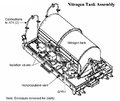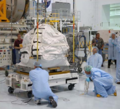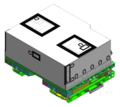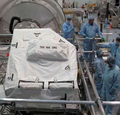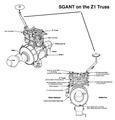
The Japanese Experiment Module (JEM), nicknamed Kibō, is a Japanese science module for the International Space Station (ISS) developed by JAXA. It is the largest single ISS module, and is attached to the Harmony module. The first two pieces of the module were launched on Space Shuttle missions STS-123 and STS-124. The third and final components were launched on STS-127.

The Mobile Servicing System (MSS) is a robotic system on board the International Space Station (ISS). Launched to the ISS in 2001, it plays a key role in station assembly and maintenance; it moves equipment and supplies around the station, supports astronauts working in space, and services instruments and other payloads attached to the ISS and is used for external maintenance. Astronauts receive specialized training to enable them to perform these functions with the various systems of the MSS.

STS-96 was a Space Shuttle mission to the International Space Station (ISS) flown by Space Shuttle Discovery, and the first shuttle flight to dock at the International Space Station. The shuttle carried the Spacehab module in the payload, filled with cargo for station outfitting. STS-96 launched from Kennedy Space Center, Florida, on 27 May 1999 at 06:49:42 AM EDT and returned to Kennedy on 6 June 1999, 2:02:43 AM EDT.

STS-102 was a Space Shuttle mission to the International Space Station (ISS) flown by Space Shuttle Discovery and launched from Kennedy Space Center, Florida. STS-102 flew in March 2001; its primary objectives were resupplying the ISS and rotating the Expedition 1 and Expedition 2 crews.

Dextre, also known as the Special Purpose Dexterous Manipulator (SPDM), is a two armed robot, or telemanipulator, which is part of the Mobile Servicing System on the International Space Station (ISS), and does repairs otherwise requiring spacewalks. It was launched March 11, 2008 on mission STS-123.

External stowage platforms (ESPs) are key components of the International Space Station (ISS). Each platform is made from steel and serves as an external pallet that can hold spare parts, also known as orbital replacement units (ORUs), for the space station. As a platform it is not pressurized, but does require electricity to power the heaters of some of the stored equipment. ORUs are attached to the ESP via Flight Releasable Attachment Mechanisms (FRAMs), matching witness plates that mate the ORU to the platform.

STS-127 was a NASA Space Shuttle mission to the International Space Station (ISS). It was the twenty-third flight of Space ShuttleEndeavour. The primary purpose of the STS-127 mission was to deliver and install the final two components of the Japanese Experiment Module: the Exposed Facility, and the Exposed Section of the Experiment Logistics Module (ELM-ES). When Endeavour docked with the ISS on this mission in July 2009, it set a record for the most humans in space at the same time in the same vehicle, the first time thirteen people have been at the station at the same time. It also tied the record of thirteen people in space at any one time.

STS-133 was the 133rd mission in NASA's Space Shuttle program; during the mission, Space Shuttle Discovery docked with the International Space Station. It was Discovery's 39th and final mission. The mission launched on 24 February 2011, and landed on 9 March 2011. The crew consisted of six American astronauts, all of whom had been on prior spaceflights, headed by Commander Steven Lindsey. The crew joined the long-duration six person crew of Expedition 26, who were already aboard the space station. About a month before lift-off, one of the original crew members, Tim Kopra, was injured in a bicycle accident. He was replaced by Stephen Bowen.

STS-123 was a Space Shuttle mission to the International Space Station (ISS) which was flown by Space Shuttle Endeavour. STS-123 was the 1J/A ISS assembly mission. The original launch target date was 14 February 2008 but after the delay of STS-122, the shuttle was launched on 11 March 2008. It was the twenty-fifth shuttle mission to visit the ISS, and delivered the first module of the Japanese laboratory, Japanese Experiment Module (Kibō), and the Canadian Special Purpose Dexterous Manipulator, (SPDM) Dextre robotics system to the station. The mission duration was 15 days and 18 hours, and it was the first mission to fully utilize the Station-to-Shuttle Power Transfer System (SSPTS), allowing space station power to augment the shuttle power systems. The mission set a record for a shuttle's longest stay at the ISS.
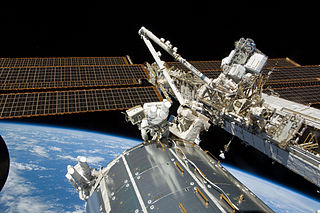
STS-129 was a NASA Space Shuttle mission to the International Space Station (ISS). Atlantis was launched on November 16, 2009 at 14:28 EST, and landed at 09:44 EST on November 27, 2009 on runway 33 at the Kennedy Space Center's Shuttle Landing Facility. It was also the last shuttle launch of the 2000s.

STS-131 was a NASA Space Shuttle mission to the International Space Station (ISS). Space ShuttleDiscovery launched on 5 April 2010 at 6:21 am from LC-39A, and landed at 9:08 am on 20 April 2010 on runway 33 at the Kennedy Space Center's Shuttle Landing Facility. The mission marked the longest flight for Space Shuttle Discovery.

STS-132 was a NASA Space Shuttle mission, during which Space Shuttle Atlantis docked with the International Space Station on 16 May 2010. STS-132 was launched from the Kennedy Space Center on 14 May 2010. The primary payload was the Russian Rassvet Mini-Research Module, along with an Integrated Cargo Carrier-Vertical Light Deployable (ICC-VLD). Atlantis landed at the Kennedy Space Center on 26 May 2010.
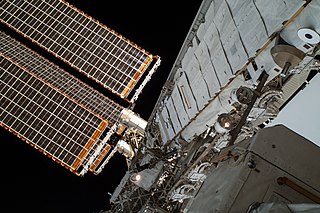
The Integrated Truss Structure (ITS) of the International Space Station (ISS) consists of a linear arranged sequence of connected trusses on which various unpressurized components are mounted such as logistics carriers, radiators, solar arrays, and other equipment. It supplies the ISS with a bus architecture. It is approximately 110 meters long and is made from aluminum and stainless steel.
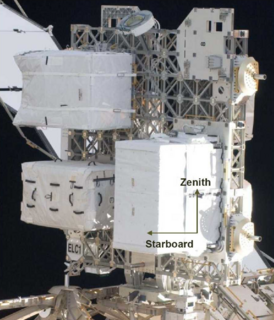
An EXpedite the PRocessing of Experiments to Space Station (ExPRESS) Logistics Carrier (ELC) is an unpressurized attached payload platform for the International Space Station (ISS) that provides mechanical mounting surfaces, electrical power, and command and data handling services for Orbital Replacement Units (ORUs) as well as science experiments on the ISS. The ELCs were developed primarily at the Goddard Space Flight Center in Greenbelt, Maryland, with support from JSC, KSC, and MSFC. ELC was formerly called "Express Pallet" and is the unpressurized counterpart to the pressurized ExPRESS Rack. An ELC provides scientists with a platform and infrastructure to deploy experiments in the vacuum of space without requiring a separate dedicated Earth-orbiting satellite.

STS-134 was the penultimate mission of NASA's Space Shuttle program and the 25th and last spaceflight of Space ShuttleEndeavour. This flight delivered the Alpha Magnetic Spectrometer and an ExPRESS Logistics Carrier to the International Space Station. Mark Kelly served as the mission commander. STS-134 was expected to be the final space shuttle mission if STS-135 did not receive funding from Congress. However, in February 2011, NASA stated that STS-135 would fly "regardless" of the funding situation. STS-135, flown by Atlantis, took advantage of the processing for STS-335, the Launch On Need mission that would have been necessary if the STS-134 crew became stranded in orbit.

Since construction started, the International Space Station programme has had to deal with several maintenance issues, unexpected problems and failures. These incidents have affected the assembly timeline, led to periods of reduced capabilities of the station and in some cases could have forced the crew to abandon the space station for safety reasons, had these problems not been resolved.

Kounotori 2, also known as HTV-2, was launched in January 2011 and was the second Japanese H-II Transfer Vehicle to resupply the International Space Station (ISS). It was launched by the H-IIB Launch Vehicle No. 2 manufactured by Mitsubishi Heavy Industries (MHI) and JAXA. After the supplies were unloaded, Kounotori 2 was loaded with waste material from ISS, including used experiment equipment and used clothes. Kounotori 2 was then unberthed and separated from the ISS and burned up upon reentering the atmosphere on 30 March 2011.

The US Orbital Segment (USOS) is the name given to the components of the International Space Station (ISS) constructed and operated by the United States National Aeronautics and Space Administration (NASA), European Space Agency (ESA), Canadian Space Agency (CSA) and Japan Aerospace Exploration Agency (JAXA). The segment currently consists of eleven pressurized components and various external elements, all of which were delivered by the Space Shuttle.

Integrated Cargo Carrier (ICC) was a project, started in 1997 by the companies Spacehab and Airbus DS Space Systems, to develop a family of flight proven and certified cross-the-bay cargo carriers designed to fly inside the Space Shuttle cargo bay, installed either horizontally or vertically, and able to carry up to 8000 lbs. of unpressurized cargo into orbit. Airbus owns the ICC fleet of carriers.

The International Space Station (ISS) External Active Thermal Control System (EATCS) maintains an equilibrium when the ISS environment or heat loads exceed the capabilities of the Passive Thermal Control System (PTCS). Note Elements of the PTCS are external surface materials, insulation such as Multi-Layer Insulation (MLI), or Heat Pipes. The EATCS provides heat rejection capabilities for all the U.S. pressurized modules, the Japanese Experiment Module (JEM), the Columbus Orbital Facility (COF), and the main power distribution electronics of the S0, S1 and P1 Trusses. The EATCS consists of two independent Loops, which both use mechanically pumped fluid state ammonia in closed-loop circuits. The EATCS is capable of rejecting up to 70 kW, and provides a substantial upgrade in heat rejection capacity from the 14 kW capability of the Early External Active Thermal Control System (EEATCS) via the Early Ammonia Servicer (EAS), which was launched on STS-105 and installed onto the P6 Truss.

















